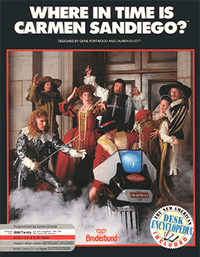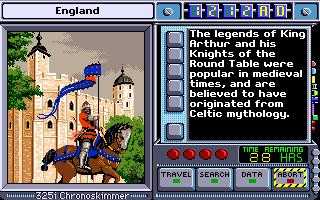Where in Time Is Carmen Sandiego? (video game)
| Where in Time Is Carmen Sandiego? | |
|---|---|
 Cover art | |
| Developer(s) | Brøderbund |
| Publisher(s) | Brøderbund |
| Designer(s) | Gene Portwood, Lauren Elliot |
| Series | Carmen Sandiego |
| Platform(s) | PC (Amiga, Apple II Commodore 64, DOS), NES, SNES, Sega Genesis |
| Release date(s) | August 1989 |
| Genre(s) | Educational/science fiction/strategy |
| Mode(s) | Single player |
The 1989 version of Where in Time Is Carmen Sandiego? is a multiplatform video game where players have to travel through time to collect the clue and the warrant necessary to capture Carmen Sandiego or one of her henchmen. The goal of this game is to track Carmen's villains through history and arrest them and ultimately arrest Carmen herself.
Similar to World, the player plays as a secret agent for the Acme Detective Agency, and has to use the research books to crack the clues given to them on where the crook went to, and also decode the physical attributes or interests of the crook based on other clues. They must achieve both these objectives in order to secure an arrest warrant, which allows them to identify the person at the end of the case as the crook. The player travels through time and space with a device known within the Carmen Sandiego universe as the Chronoskimmer. The game is time limited, and every action one takes uses up some of that time; the player needs to solve the case within the allotted time in order to be successful. As well as teaching the player about both geography and history it also provides practice with using a research book – the New American Desk Encyclopedia comes with the game for assistance.[1] The people, events, and inventions featured in the game hail from period in history ranging from 400 AD to the 1950s – the past 1500 years of human history.[2] The game comes with a 28-page instruction manual.[3]
This was the first game in the series to establish that ACME Headquarters is located in San Francisco.
The game was released on a variety of different platforms including: Apple II (1989), Amiga (1990), Commodore 64/128 (1990), Macintosh (1990, IBM PC Compatible (1990), DOS (1990), Nintendo Entertainment System (1991), Sega Genesis (1992), Super Nintendo Entertainment System (1993).[4][5]
In 1991, Konami released a port of the game for the Nintendo Entertainment System which included a small, paperback encyclopedia as a free pack-in. Hi Tech Expressions later created a port for the Super NES. Electronic Arts also created a port for the Sega Genesis.
From the time the game was released (August 1989) up until January 21, 1990, the game had sold "more than 100,000 copies". The game was "the best-selling software game during the 1989 holiday season"[6]
Gene Portwood and Lauren Elliott were the designers for the game, Lance Groody and Rod Nelson were the programmers, Don Albrecht, Leila Bronstein, Michelle Bushneff, Maureen Gilhooly, Julie Glavin, Avril Harrison and Barbara Lawrence all worked on graphics, Clair Curtin was the product manager, Susan Meyers wrote the clues, and Matthew Leeds wrote the manual.[7]
Gameplay
Players start out as a Time Cadet (and throughout the game get promoted to Time Patroller, Time Investigator, Time Inspector, Time Detective, Ace Time Detective, and finally Super Time Sleuth), and need to "Track the criminals' movements, figure out where he or she is going next, obtain a warrant for his or her arrest, and send a 'Capture Robot' to arrest the thief".[3] The player finds this hideout by following the "trail throughout the time stream". The player asks people for clues, and every travel clue given at a location gives the player a hint as to the next destination. The player clicks on whichever of the 4 travel option fits the clue, and is then sent there to receive the next clue. They know if they reach the correct location if they see a short animation of a VILE agent upon arrival. The player also gets clues about the culprit's physical appearance and what their likes/hobbies are, which the player then uses to make the warrant. The player is able to arrest the crook if they have the correct warrant and are in the correct location before the time runs out. The player has to capture 80 criminals in order to beat the game.[8]
The game can be played in five different languages: English, French, Spanish, German and Italian.[9]
Reception
Compute! in 1989 stated that Where in Time was the most exciting in the series. It concluded that "besides being one great game [it] has the added value of being an exceptional educational program".[10] Computer Gaming World also favorably reviewed the game, stating that it was "challenging and fun, as well as educational".[11] A review in the Video Game Bible for the Konami/Genesis version says that the game is "very informative" and "technically a point and click adventure game". It refers to the game as edutainment because "something could accidentally be learnt while playing". It also suggests that Mario's Time Machine is a rip-off of this "not as popular as Where in the World is Carmen Sandiego" game. It says the Hi Tech version was essentially the same as the NES version and was also available on the Commodore 64. While there is no two-player mode, the book suggests it is "a little bit fun...when two friends who are interested in history are playing together".[12]
A review by Something Awful gave a mixed response. It found that "the mission of learning historical facts worked but unfortunately came with the fatal flaw of having absolutely no confidence in my answers". The rating system for the site is that the scores for each section range from 0 (the "best) to −10 (the "worst). The game was given −2 for graphics, −8 for gameplay, −4 for story, −10 for sound and −10 for fun. The overall score was −34 out of a possible "worst score" of −50.[8] A Newsday review noted its educational nature, saying it is "unlike most other video games which contain fast-paced action". It gave the game a rating of 8 out of 10.[9] On March 1, 1993, Nintendo Power gave the SNES version of the game a score of 3.2/5 [13] A Power Play review for the Genesis version, published in June 1992, game the game a score of 57 out of 100.[14] Nintendo Power Magazine gave the version a score of 3.6 out of 5 in November 1991, and Electronic Gaming Monthly (EGM) gave the version a rating of 58 in November 1991 as well. GamePro (US) gave the NES version a rating of 5 out of 5 in December 1991.[15]
A 1998 allgame review of the Macintosh version of the game by Lisa Karen Savignano commented on the games sameness to the previous World title, and insinuated that a player's response to one game would determine how they respond to the other. She comments that the animated clip of the robot capturing the criminal "is cute the first couple of times you see it, but quickly grows boring and tiresome to the older set" She also commented on the "realistic sounds" of the deathtraps and the "improbable-sounding names" of the villains. Overall, she gave the game a score of 3/5 stars. This breaks down into: 3 stars for graphics ("static and photorealistic [and] cartoony"), 3.5 stars for sound ("they tell you if you...are on the right track"), 2 stars for enjoyment ("older kids may find it tiresome and continually the same"), 3.5 stars for replay value ("the game always plays differently each time, but your 80th case is always Carmen Sandiego", and 3 stars for documentation ("a slim manual...explains the basics of the game"). [16]
In 2014, The Av Club described the game as "the closest thing to a good Doctor Who game", arguing that "Where In Time still replicated the sense of adventure, danger, and mystery that gives Doctor Who so much of its life." The site added "The rhythms of each mission mirror an episode of Doctor Who almost exactly: The hero turns up unannounced, sticks his nose where it doesn’t belong, solves a mystery in the nick of time, and zips away without bothering with cleanup or paperwork. Players travel through time in a Chronoskimmer that functions much the same way as the Doctor’s TARDIS, serving as not just a vehicle but also as a mobile lab and headquarters. The Chronoskimmer’s scanner is similarly reminiscent of the Doctor’s sonic screwdriver, since both are all-purpose gadgets used to quickly pick useful information out of a scene, and both make satisfying electronic chirping noises when used."[17]

Times
Time #1 is from 400 to 1300.
Time #2 is 1300 to 1700.
Time #3 is 1700 to 1900.
Time #4 is past 1900.
Places
China, times 1, 2, 3, 4
England, times 1, 2, 3, 4
France, times 1, 2, 3, 4
Holland, time 1, 2, 3, 4
India, times 1, 2, 3, 4
Italy, time 1, 2, 3, 4
Japan, time 1, 2, 3, 4
Mexico, time 1, 2, 3, 4
Peru, time 1, 2, 3, 4
Russia, time 1, 2, 3, 4
Spain, time 1, 2, 3, 4
USA, time 1, 2, 3, 4
References
- ↑ Computers. Boys' Life. January 1990. Retrieved October 27, 2012.
- ↑ "Your Place For Computers!". The Sarasota Herald-Tribune. October 16, 1990. Retrieved October 27, 2012.
- ↑ 3.0 3.1 Woods, Nick. "Where in Time Is Carmen Sandiego? Synopsis". allgame. Retrieved October 28, 2012.
- ↑ Woods, Nick. "Where in Time Is Carmen Sandiego? Synopsis". allgame. Retrieved October 28, 2012.
- ↑ "Where in Time is Carmen Sandiego?". MobyGames. Retrieved October 28, 2012.
- ↑ "CARMEN SANDIEGO IS ON FIRE". San Jose Mercury News. January 21, 1990. Retrieved October 27, 2012.
- ↑ "Where in Time Is Carmen Sandiego? Credits". allgame. Retrieved October 28, 2012.
- ↑ 8.0 8.1 Kevin "The Goblin" Wilson (March 3, 2007). "Where in Time is Carmen Sandiego?". Something Awful. Retrieved October 27, 2012.
- ↑ 9.0 9.1 Suzanne Russo, Scott Kittilsen, and Christopher (August 4, 1992). "KIDSDAY STUFF KIDS BUY KIDS IN THE KITCHEN". Newsday. Retrieved October 27, 2012.
- ↑ Sternberg, Kristen (December 1989). "Where in Time is Carmen Sandiego?". Compute!. p. 72. Retrieved 11 November 2013.
- ↑ Wagner, Roy (March 1990). "Where in Time is Carmen Sandiego? / Broderbund's Success Story Continues". Computer Gaming World. p. 30. Retrieved 15 November 2013.
- ↑ Slaven, Andy (2002). Video Game Bible, 1985–2002. Trafford Publishing. pp. 130, 156, 175. Retrieved October 27, 2012.
- ↑ "Where in Time Is Carmen Sandiego? Critic Reviews for SNES – GameSpot". Au.gamespot.com. 1993-03-01. Retrieved 2011-02-03.
- ↑ "Where in Time is Carmen Sandiego? Genesis". MobyGames. Retrieved October 28, 2012.
- ↑ "Where in Time is Carmen Sandiego? NES". MobyGames. Retrieved October 28, 2012.
- ↑ Savignano, Lisa Karen (1998). "Where in Time Is Carmen Sandiego? Review". allgame. Retrieved October 28, 2012.
- ↑ http://www.avclub.com/article/where-time-carmen-sandiego-closest-thing-good-doct-208119
External links
- Gamefaqs NES Site 1
- Gamefaqs NES Site 2
- Edutainment Odyssey, Episode 1 – Where in Time is Carmen Sandiego?